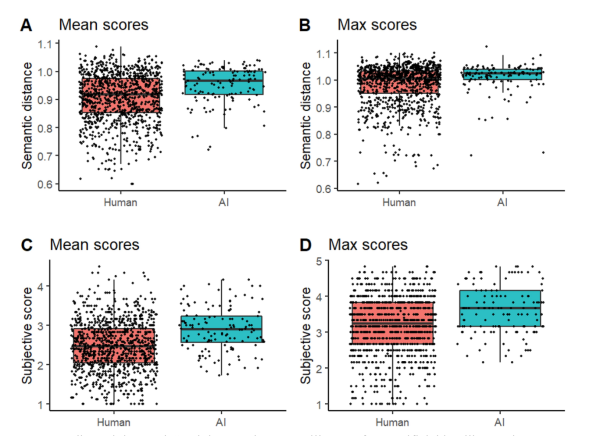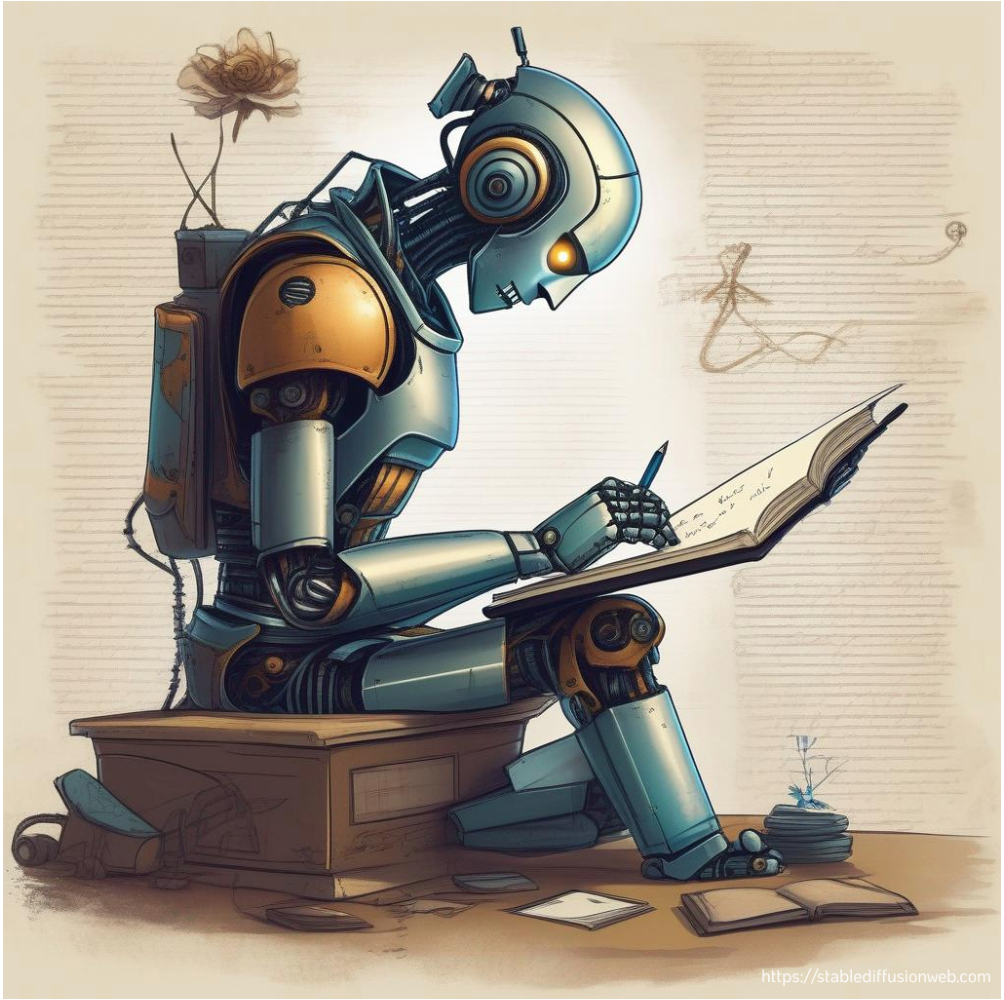Image credit: Shaumprovo Debnath. Made using stablediffusionweb.com with the prompt “a robot thoughtfully writing a poem.”
Ever since the release of ChatGPT in November, 2022 (or rather, since its explosion in popularity in 2023 , since GPT-3 was first released in 2020), AI chatbots have been both promising and somewhat frightening in their potential. Many have already incorporated them into their day-to-day lives: students to help make study questions, employees to expedite making spreadsheets, and programmers to debug. They are a tool that we can leverage to facilitate monotonous and straightforward tasks. But what if these chatbots could outperform us in something not so concrete and linear, but something instead decidedly human?
One of the main attributes that defines what it means to be human has come into question — creativity. Only humans are meant to be able to do creative things. In fact, this is still one of the main arguments against AI art, that it only knows how to steal and replicate styles. But if chatbots can already pass the Turing test, can they also exercise creativity? And if so, what does that mean for us?
A study published in Nature evaluates the ability of chatbots to show creative thought compared to humans. The test for creativity that they used is known as the Alternate Uses Task, which involves finding uses for every-day objects that are unique. By connecting two very different ideas — an object and its use — creativity is exemplified according to the associative theory of creativity, a theory which has support from brain imaging of blood flow to different parts being increased during such tasks. Finding alternate uses also shows divergent thinking, demonstrating uniqueness of ideas.
They gave this task to humans, ChatGPT-3.5, ChatGPT-4, and Copy.ai. The specific objects they were given were a rope, a box, a pencil, and a candle. The prompt was as follows:
“For the next task, you’ll be asked to come up with original and creative uses for an object. The goal is to come up with creative ideas, which are ideas that strike people as clever, unusual, interesting, uncommon, humorous, innovative, or different. Your ideas don’t have to be practical or realistic; they can be silly or strange, even, so long as they are creative uses rather than ordinary uses. You may type in as many ideas as you can, but creative quality is more important than quantity. It’s better to have a few really good ideas than a lot of uncreative ones. You have 30 s to respond to each object.”
To evaluate how creative a response was, the study used both a computational model and blind human judges who assumed all of the responses were human and ranked them on a scale of 1–5, with 1 being a totally un-creative response, such as using scissors to “cut,” and 5 being something very creative. The computational model involved finding the semantic distance between words, or how similar they mean and how often they appear next to each other. A great way to visualize this is to play the game “pimantle,” where the goal is to find the word based on the semantic distance of your guesses. I’m more interested in the human judges’ scores, since I’ve often been frustrated by being misled by a seemingly completely irrelevant word when playing pimantle.
Well, now the exciting part: who scored better? On average, it was the chatbots.
 Image credit: Koivisto and Cassini, “Best humans still outperform artificial intelligence in a creative divergent thinking task.” Published in Nature.
Image credit: Koivisto and Cassini, “Best humans still outperform artificial intelligence in a creative divergent thinking task.” Published in Nature.
When both the computational model and human judges scored the AIs and humans, the average of the scores were higher in every test.
But it’s not a loss for humanity quite yet. The highest scores actually all (except for 3 in specific scenarios, not averages) belonged to humans. Meaning although the chatbots are more creative than the average human, the most creative humans are more creative than them.
So what’s next for humanity? Well from here the scientific aspect is lost and we move into the realm of speculation, but I’ll give my two cents. Even if these chatbots show creativity in idea generation tasks, their writing is not anything I’d consider “creative” yet. Although, it’s important to note that they’re not trained to be, and maybe a GPT-4 model trained on the finest poetry would be indistinguishable. Your output can only be as good as your input. But even then, I don’t think the jobs of the creative (specifically creative writing) industry are going anywhere. Maybe a hundred years from now a single AI-generated book will be required reading for students, as an exercise in distinguishing what’s human and what’s not, but everything else will be human-written. On the topic of English classes, any English teacher will tell you that the background of an author is a crucial part of the literature. Even if the works are indistinguishable, no one wants to write AI-generated emotion. The magic is gone as soon as you learn that the author was a bunch of 0s and 1s going word-by-word. Mainly because these AIs were trained to imitate humans, and they may never be at the forefront.
That brings us to the next question — will AIs get more creative, or will the most creative humans always be more creative than the most creative AIs? I lean towards the latter. I believe that the more creative AIs get, the more creative humans will become in response. Although it’s important to recognize how strange it is to be speaking of people becoming more creative. Have people gained more knowledge over the years? Yes. Have they gotten smarter? Or born with any more common sense? No. Perhaps creativity is like common sense: something so (supposedly) ingrained in us it is not trainable.
What seems clear to me, however, is that creativity in AI is something beyond summarizing passages, making spreadsheets, or writing code. It’s not something that has an immediate use that we can use as a tool. It could instead be used as a collaborator: for example, a spark in idea generation for someone suffering from writers’ block, or, in the case of art, a way to speed up the agonizing process of learning to draw figures (hands might be something both humans and AIs struggle with for a while though).
Ultimately, anything AI spits out, is a mere imitation of what humans put in. So really, there’s nothing to fear, but rather, everything to look forward to.


